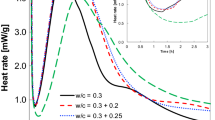Abstract
Extrusion is not a common way to form firm cement-based material. Due to material frictional behaviour, drainage phenomenon appears and leads to process blockage. The properties of the extrusion multiphase flow of such specific materials have to be highlighted to understand the properties of the process flow. An extrudible mortar is formulated according to extrusion criteria provided by literature tests developed to describe the evolution of the paste undergoing extrusion. To study the relationship between flow properties, extrusion force and material consolidation, a technique based on the measurement of paste hardness in the billet zone is developed. Measurements of the local paste density and flow visualisation are also performed. Results show that in the range of used ram velocities, filtration occurs between fluid and solid phases. This creates zones of preferential flow and of non-flowing consolidated material.












Similar content being viewed by others
References
Burbidge AS, Bridgwater J, Saracevic Z (1995) Liquid migration in paste extrusion. Trans IchemE 73(A):810–816
Coussot P, Ancey C (1999) Rheophysical classification of concentrated suspensions and granular pastes. Phys Rev Lett E 59(4):4445–4456
Götz J, Buggish H, Peciar M (1993) NMR imaging of pastes in a ram extruder. J Non-Newton Fluid Mech 49:251–275
Götz J, Kreibich W, Peciar M (2002) Extrusion with a piston extruder for the determination of the local solid and fluid concentration, the local porosity and saturation and displacements profiles by means of NMR imaging. Rheol Acta 41:134–143
Hill R (1950) Mathematical theory of plasticity. Clarendon, Oxford
Li Y, Burbidge AS, Bridgwater J, Saracevic Z (1995) Liquid migration in paste extrusion. Trans IchemE 73(A):810–816
Mu B, Li Z, Chui SNC, Peng J (1999) Cementitious composite manufactured by extrusion technique. Cem Concr Res 29:237–240
Peled A, Shah SP (1999) Processing effects in cementitious composites: extrusion and casting. J Mater Civ Eng 29:237–240
Perrot A, Lanos C, Estellé P, Mélinge Y (2006) Ram extrusion force for a frictional plastic material: model prediction and application to cement paste. Rheol Acta 45:457–467
Steffe JF (1996) Rheological methods in food engineering process, second edition. Freeman, East Lansing, USA
Toutou Z, Lanos C, Mélinge Y (2004) The use of squeezing test-extrusion flow similitude to identify cement based materials extrudability. Proc XIVth Int Congr On Rheology, Seoul
Toutou Z, Roussel N, Lanos C (2005) The squeezing test, a tool to identify firm cement based material’s rheological behaviour and evaluate their extrusion ability. Cem Concr Res 35:1891–1899
Author information
Authors and Affiliations
Corresponding author
Rights and permissions
About this article
Cite this article
Perrot, A., Lanos, C., Melinge, Y. et al. Mortar physical properties evolution in extrusion flow. Rheol Acta 46, 1065–1073 (2007). https://doi.org/10.1007/s00397-007-0195-6
Received:
Accepted:
Published:
Issue Date:
DOI: https://doi.org/10.1007/s00397-007-0195-6




